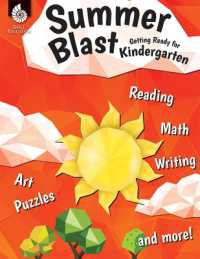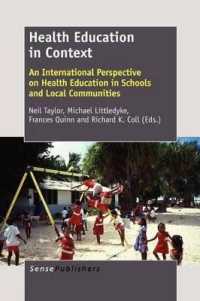Full Description
Transform your mathematics instruction with this rich collection of formative assessment techniques
Award-winning author Page Keeley and mathematics expert Cheryl Rose Tobey apply the successful format of Keeley's best-selling Science Formative Assessment to mathematics. They provide 75 formative assessment strategies and show teachers how to use them to inform instructional planning and better meet the needs of all students. Research shows that formative assessment has the power to significantly improve learning, and its many benefits include:
Stimulation of metacognitive thinking
Increased student engagement
Insights into student thinking
Development of a discourse community
The authors also provide important guidance with each technique, including usage tips and caveats, implementation examples, and suggested modifications. With practical strategies that are relevant for all grades and topic areas, Mathematics Formative Assessment provides the tools to transform teaching and learning in your classroom.
Contents
Preface
Acknowledgments
About the Authors
1. An Introduction to Formative Assessment Classroom Techniques (FACTs)
What Does a Formative Assessment?Centered Classroom Look Like?
Why Use FACTs?
How Does Research Support the Use of FACTs?
Classroom Environments That Support Formative Assessment
Connecting Teaching and Learning
Making the Shift to a Formative Assessment-Centered Classroom
2. Integrating FACTs With Instruction and Learning
Integrating Assessment and Instruction
Assessment That Promotes Thinking and Learning
Linking Assessment, Instruction, and Learning: The Mathematics Assessment, Instruction, and Learning Cycle (MAIL Cycle)
Stages in the MAIL Cycle
Engagement and Readiness
Eliciting Prior Knowledge
Exploration and Discovery
Concept and Skill Development
Concept and Procedure Transfer
Self-Assessment and Reflection
Selecting and Using FACTs to Strengthen the Link Between Assessment, Instruction, and Learning
3. Considerations for Selecting, Implementing and Using Data From FACTs
Selecting FACTs
Selecting FACTs to Match Learning Goals
FACTs and the Common Core Standards for Mathematics
Selecting FACTs to Match Teaching Goals
The Critical Importance of Classroom Context in Selecting FACTs
Planning to Use and Implement FACTs
Starting Off With Small Steps
Maintaining and Extending Implementation
Using Data From the FACTs
4. Get the FACTs! 75 Mathematics Formative Assessment Classroom Techniques (FACTs)
#1. A & D Statements
#2. Agreement Circles
#3. Always, Sometimes, or Never True
#4. Card Sorts
#5. CCC: Collaborative Clued Corrections
#6. Comments-Only Marking
#7. Commit and Toss
#8. Concept Attainment Cards
#9. Concept Card Mapping
#10. Concept Cartoons
#11. Create the Problem
#12. Every Graph Tells a Story
#13. Example, Nonexample
#14. Fact-First Questioning
#15. Feedback to Feed-Forward
#16. Fist to Five
#17. Four Corners
#18. Frayer Model
#19. Friendly Talk Probes
#20. Give Me Five
#21. Hot Seat Questioning
#22. Human Scatter Graph
#23. Is It Fair?
#24. I Used to Think . . . But Now I Know . . .
#25. Justified List
#26. Justified True-or-False Statements
#27. K-W-L Variations
#28. Learning Goals Inventory (LGI)
#29. Look Back
#30. Matching Cards
#31. Mathematician's Ideas Comparison
#32. More A?More B Probes
#33. Muddiest Point
#34. No-Hands Questioning
#35. Odd One Out
#36. Opposing Views Probes
#37. Overgeneralization Probes
#38. Partner Speaks
#39. Pass the Problem
#40. P-E-O Probes (Predict, Explain, Observe)
#41. Peer-to-Peer Focused Feedback
#42. A Picture Tells a Thousand Words
#43. POMS: Point of Most Significance
#44. Popsicle Stick Questioning
#45. PVF: Paired Verbal Fluency
#46. Question Generating
#47. Response Cards
#48. Same A?Same B Probes
#49. Sequencing Cards
#50. Sticky Bars
#51. Strategy Harvest
#52. Strategy Probe
#53. Student Evaluation of Learning Gains
#54. Student Interviews
#55. Terminology Inventory Probe (TIP)
#56. Ten-Two
#57. Thinking Log
#58. Think-Alouds
#59. Think-Pair-Share
#60. Thought Experiments
#61. Three-Minute Pause
#62. 3-2-1
#63. Thumbs Up, Thumbs Down
#64. Traffic Light Cards
#65. Traffic Light Cups
#66. Traffic Light Dots
#67. Two-Minute Paper
#68. Two or Three Before Me
#69. Two Stars and a Wish
#70. Two Thirds Testing
#71. Volleyball, Not Ping-Pong!
#72. Wait Time Variations
#73. What Are You Doing and Why?
#74. Whiteboarding
#75. Word Sort
Appendix: Annotated Resources for Mathematics Formative Assessment
References
Index







